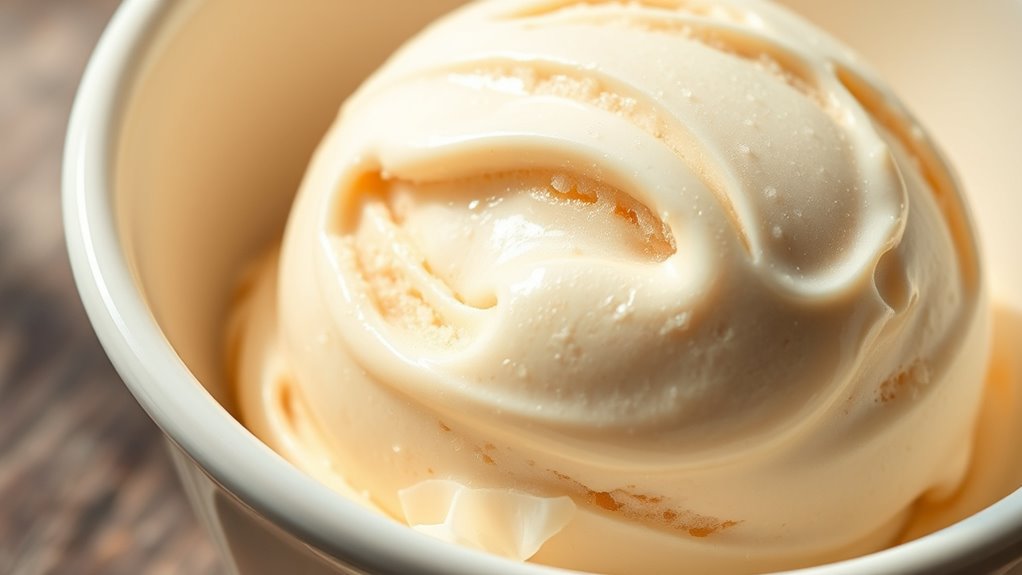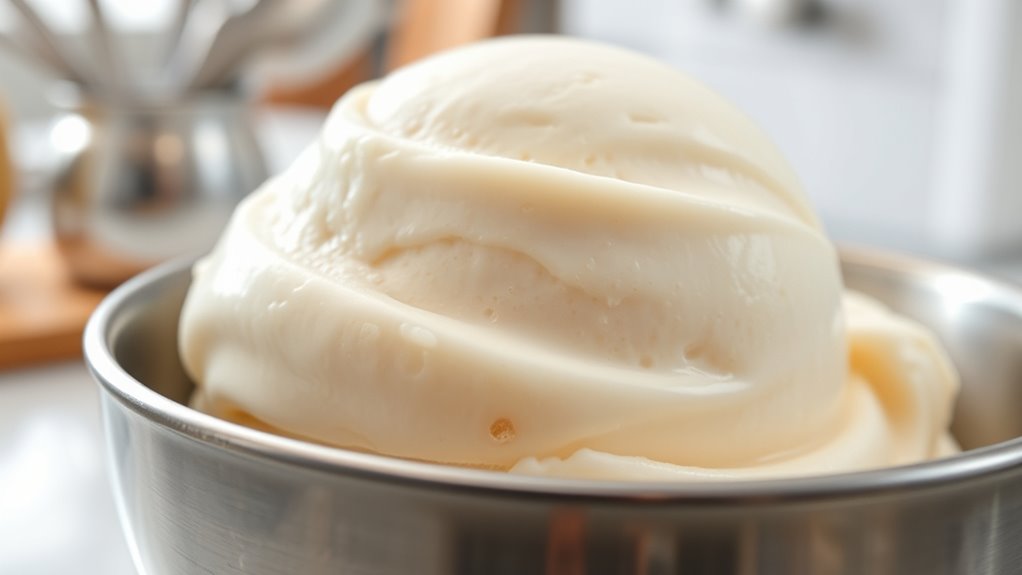The science behind gelato’s texture lies in its low overrun, which keeps it denser and creamier by incorporating less air. Rapid freezing at lower temperatures prevents large ice crystals from forming, ensuring a smooth, velvety mouthfeel. Stabilizers and emulsifiers help bind water and fats, promoting a stable crystalline structure. Proper ingredient ratios also lower the freezing point, maintaining softness and scoopability. Explore further to uncover the detailed techniques that create this unique, luxurious dessert.
Key Takeaways
- Low overrun (20-30%) creates a denser, creamier, and velvety texture compared to traditional ice cream.
- Tiny ice crystals (<50 microns) formed through rapid freezing ensure a smooth, melt-in-your-mouth sensation.
- Precise temperature control and rapid freezing techniques prevent large crystal growth, maintaining creaminess.
- Stabilizers and emulsifiers bind water and fats, reducing crystal growth and ensuring a stable, smooth crystalline structure.
- Ingredient ratios of sugar, fat, and solids influence freezing point depression, affecting scoopability and texture.

Gelato’s irresistibly smooth texture comes down to precise scientific techniques that control its freezing process. Unlike traditional ice cream, gelato has a low overrun—typically 20-30%—meaning less air is whipped into it, resulting in a denser, creamier consistency.
Achieving this involves carefully managing the freezing process to produce tiny ice crystals, usually less than 50 microns in size. These small ice crystals give gelato its velvety mouthfeel because they melt quickly on your tongue, creating a smooth sensation without a crunchy or icy texture.
The key to forming these tiny crystals lies in controlling the temperature during freezing. Rapid freezing at lower temperatures prevents large ice crystals from developing, and the use of stabilizers like guar gum and carob bean gum further aids this process. These stabilizers bind water molecules, reducing the amount available for crystal growth and preventing large, coarse crystals from forming.
This is essential because crystal formation directly influences the texture—smaller crystals mean a more delicate, creamy consistency. Additionally, controlling the freezing point through ingredient ratios is crucial for maintaining the desired softness and scoopability.
The freezing point of gelato is also carefully manipulated. The right balance of sugar, fat content, and other solids depresses the freezing point, so gelato remains soft and scoopable at temperatures around -14°C. This balance is achieved by adjusting ingredient ratios, ensuring the gelato doesn’t freeze into a solid block but stays creamy and easily served.
Emulsifiers play an important role here as well—they help blend fat and water evenly, creating a stable mixture that resists crystal growth during freezing. This prevents the formation of ice crystals large enough to ruin the smooth texture.
The entire process hinges on quick freezing techniques combined with ingredient choices that inhibit crystal growth. By controlling the freezing process, you create an environment where small ice crystals can form and remain stable, offering that signature velvety mouthfeel.
Properly managing temperature, stabilizers, emulsifiers, and ingredient ratios ensures the gelato’s crystalline structure remains fine and uniform. This scientific approach guarantees that every spoonful delivers the luxurious, smooth texture that makes gelato so appealing, setting it apart from other frozen desserts.
Frequently Asked Questions
What Gives Gelato Its Texture?
You might wonder what makes gelato so irresistibly smooth and creamy. It’s the low overrun, meaning less air is whipped in, giving it a dense texture.
Plus, its 6% fat content and use of stabilizers help create that silky mouthfeel. Rapid freezing keeps ice crystals tiny, ensuring smoothness.
Serving it slightly warmer enhances its softness, making every scoop velvety and rich.
What Makes Gelato so Smooth?
You notice that gelato feels so smooth because of its unique ingredients and process. Stabilizers like guar gum prevent large ice crystals from forming.
While the slow churning introduces less air, making it denser and creamier. Serving it slightly warmer enhances its soft texture and flavor.
Plus, rapid freezing creates tiny ice crystals, all working together to give you that irresistibly silky, smooth mouthfeel you love.
What Makes Gelato so Creamy?
Think of gelato as a whisper of silk on your tongue. Its lower fat content allows proteins to emulsify better, creating a smoother, creamier mouthfeel.
The slow churning process introduces less air, making it denser and richer. Serving it slightly warmer keeps it soft and velvety.
Stabilizers prevent icy crystals, ensuring every bite remains consistently creamy, so you truly savor that luxurious, melt-in-your-mouth sensation.
What Is the Science Behind Soft Serve Ice Cream?
You might wonder what makes soft serve ice cream different. It’s mainly because it contains 20-30% air, making it lighter and fluffier.
The mixture is kept at -4°C to -6°C, which keeps it smooth and easy to serve.
Special machines rapidly freeze the mixture while adding air, and stabilizers prevent ice crystals, ensuring a creamy, soft texture that melts smoothly in your mouth.
Conclusion
Now that you understand the science behind gelato’s silky texture, you can truly appreciate each creamy scoop. It’s like a delicate ballet of ingredients and techniques working in harmony, creating a dessert that feels like a hug in every bite. So, next time you indulge, remember the fascinating science behind that luscious, melt-in-your-mouth experience. Gelato isn’t just a treat; it’s a masterpiece crafted by science, passion, and a touch of magic.









